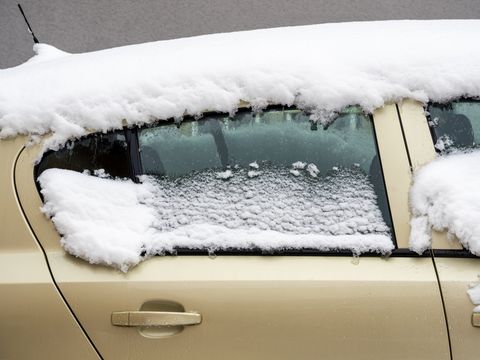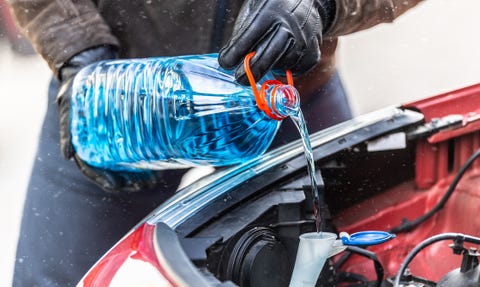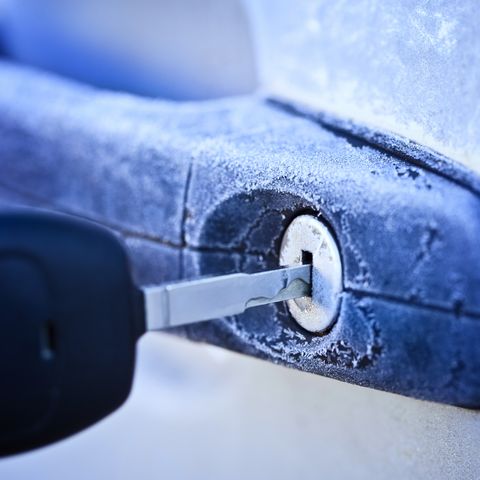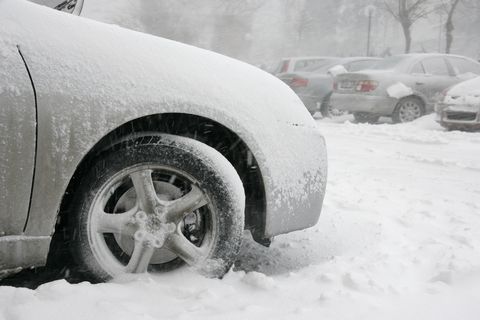- Do not use hot or hot water for thawing everything to your car.
- Those pesky frozen windshield wipers require a little extra care to prevent damage.
- In cold weather, it can be difficult to determine tire pressure.
we were all there. You're trying to rush from point A to point B in the winter, but the cold weather gets in the way and you rush to skip the steps you normally do to prevent damage to your vehicle.
So we decided to ask two experts about the most common winter car care mistakes people tend to make during the colder months, and how to prevent the damage. Kristine D'Arbelles, Senior Her Director of the Canadian Automobile Association, and David Bennett, her AAA Repair Manager, shared their thoughts. popular mechanic.
1) Driving when there is ice and snow on the exterior
Now, this is a bit obvious, but it is against the law to be an igloo on wheels. waiting. D'Arbelles is careful not to forget the interior of the car, either. "Your air conditioner is also a dehumidifier," she says.
2) Top up with regular windshield washer fluid
From the windshield ice scraper to the right part under the hood, Bennett advises always using the right part. "Don't try to set things up," he warns. One of the problems he's seen too often is people filling their windshield washer fluid with regular water when it's running low. This can cause freezing issues and prevent assembly. Use proper wiper fluid instead. There are also winter blends to prevent freezing. "You want the right liquid in there," he says.
3) Warm up the car by idling
Bennett says visibility through the windows is important for knowing how warm the car should be before driving. A car always warms up faster when driving than when idling. He says that idling your car to warm it up is "a waste of money, just a waste of gas." "Take your time to defrost your windows and make sure you're scraping the ice off. Wait until you can see the entire window, not just that tiny little spot."
4) Use windows that remain ice-covered
De-icing windows carefully. Bennett suggests not using hot water or other liquids to clean the windshield. Instead, start your car and let the heater and defroster do the hard work. Use a scraper to remove ice from windows while blowing the heat off completely.
"You don't want to put something warm on something that's already frozen," warns Bennett. "Once frozen, it becomes brittle, and introducing a temperature change makes it even more brittle, and something can crack or break."
And if the windows still have ice on them, don't start using them. The mechanisms needed to lower and raise them are very cold and can be stressed with additional ice and broken. pop mecha Editor).
5) Forgetting to unlock locks and handles
Pouring boiling water over frozen door locks and handles can damage the internal mechanisms. Please don't do it. Instead, use commercial deicing sprays, he says, D'Arbelles. Store the spray somewhere other than in your car. Otherwise, you'll end up thawing frozen locks and handles in a hurry, and you could revert to the cycle of damage.
Bennett also warns against getting water on frozen locks and handles, and suggests commercial deicers. If you don't have one, you can use a hair dryer to melt the ice around the lock. .
6) Lift the wipers before the storm
It might seem like a no-brainer to lift the wipers before a blizzard to clean your windows more easily. But that's not a good idea, says D'Arbelles. "Over time, the pressure of the blades against the windshield is likely to decrease, which can lead to visibility problems, especially in snowy conditions." If one of the unexpectedly loses tension and bounces toward the window, it can crack the windshield. Since wipers have a half-year lifespan, some drivers replace them with winter wipers to prevent trouble.
7) Ignore tire pressure
Tire pressure drops in cold weather. If you have a tire pressure sensor, it may warn you of a problem, but it's equally important to inflate your tires carefully to avoid over-inflating them.
To find the recommended tire pressure for your vehicle, look inside the driver's side door. Bennett says to follow these tire pressure requirements. They will be more specific to what your vehicle needs than the tire sidewall specifications. He also recommends filling the tires when the car is relatively cool, rather than after an hour of driving. That way the resulting pressure reading will be more accurate. As you drive, the tires heat up, the air expands and the air pressure rises, which extinguishes the low pressure warning light and gives you a sense of security. , keeping a tire pressure gauge at home can prevent problems. consumer report.
8) Keep fuel tanks low
Prevent your gas pipes from freezing knowing that the water in your tank is your enemy. "Keeping the tank at least half full will reduce condensation buildup," he says D'Arbelles.
9) Leave the paint (and undercarriage) dirty
Precautions help protect your car's exterior. Bennett suggests washing and waxing your car before the winter season so the wax can protect the paint from rust, salt, and chemicals. "And if you're driving in the mud and see that there's salt under it, wash it out of your car immediately," he says.
Tim Newcomb is a journalist based in the Pacific Northwest. He has covered stadiums, sneakers, gear, infrastructure and more in various publications including Popular Mechanics. Some of his favorite interviews include roundtables with Roger Federer in Switzerland, Kobe his Bryant in Los Angeles and Tinker his Hatfield in Portland.







